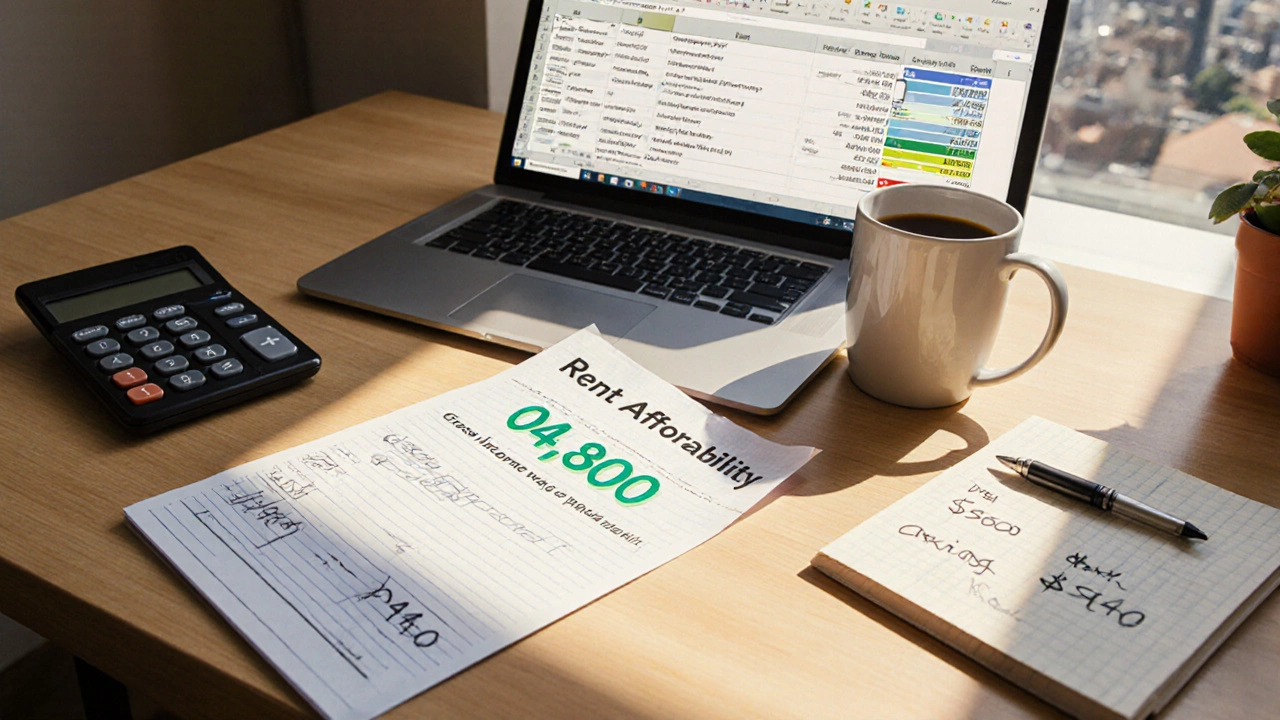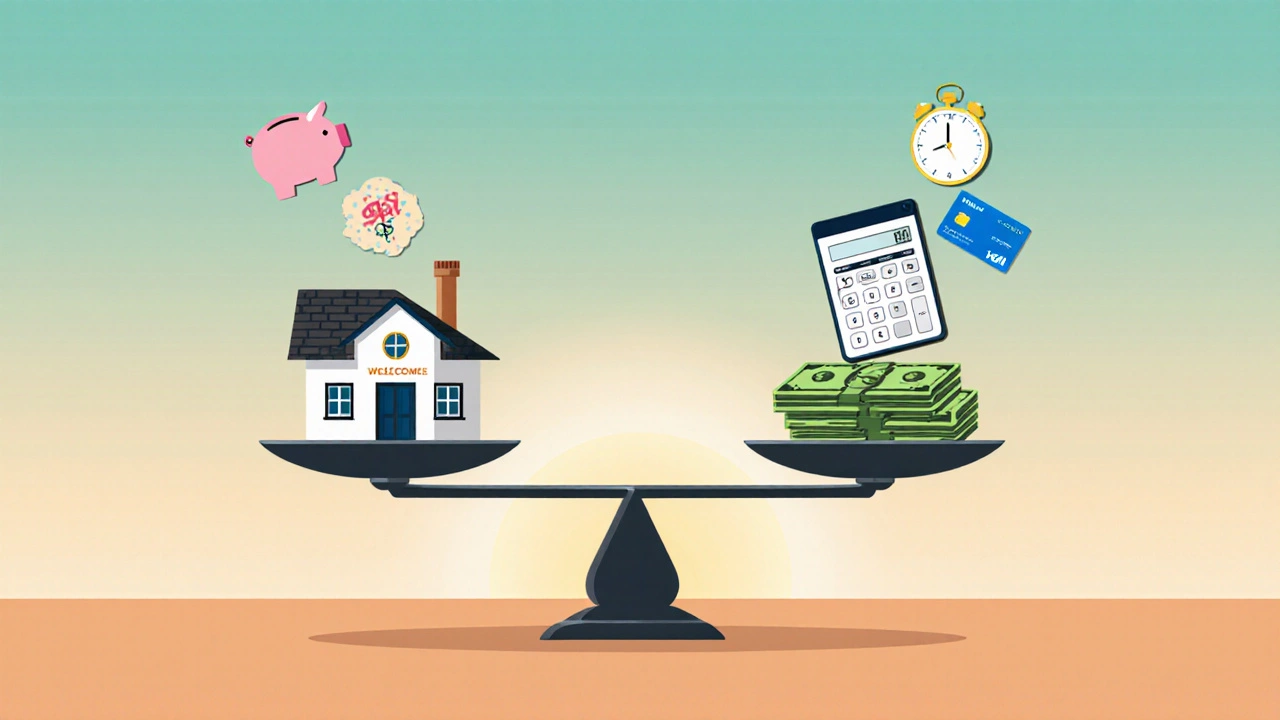Rent Affordability Calculator
How Much Rent Can You Afford?
Use this calculator to determine your maximum affordable rent based on your income, debt, savings goals, and local market factors.
Your Maximum Affordable Rent
Budget Breakdown
Finding a place to live feels like a balancing act: you want a space you love, but you also need to keep your finances healthy. The key is figuring out the maximum rent you can comfortably cover without sacrificing other goals.
Key Takeaways
- Aim for rent that’s about 30% of your gross monthly income as a safe baseline.
- Adjust the rule based on debt, savings goals, and local market pressures.
- Use a simple three‑step formula or an online rent calculator for quick results.
- Re‑evaluate regularly as your income, expenses, or market conditions change.
What is Rent Affordability?
Rent affordability is the amount of monthly rent a household can pay while still meeting all other financial obligations and savings targets. It isn’t a one‑size‑fits‑all number; it shifts with income, debt, living costs, and personal priorities.
Core Entities that Shape Your Rent Budget
Understanding the main pieces helps you build a realistic budget.
- Gross income is your total earnings before taxes or deductions. It’s the starting point for most affordability rules.
- Net income is what you actually take home after taxes, insurance, and retirement contributions. Use this if you prefer a cash‑flow‑based approach.
- Debt‑to‑income (DTI) ratio measures the percentage of income already tied up in debt payments. A high DTI means you should aim lower on rent.
- Fixed expenses include rent, utilities, insurance, and loan payments that stay the same each month.
- Variable expenses cover groceries, transportation, entertainment, and other costs that can fluctuate.
- Housing budget is the portion of your monthly cash flow earmarked for rent and related housing costs.
- Rent calculator is an online tool that plugs in your income, debts, and expenses to instantly output a rent range.
- Credit score influences the lease terms you’ll qualify for, including required security deposits and co‑signer needs.

Step‑by‑Step Formula to Find Your Maximum Rent
- Determine your gross monthly income. If you earn $4,800 per month before taxes, that’s your starting figure.
- Calculate the standard 30% benchmark: multiply gross income by 0.30. In the example, $4,800×0.30=$1,440.
- Adjust for existing debt. Add up monthly loan, credit‑card, and car payments (say $300). Subtract that from the 30% figure: $1,440−$300=$1,140.
- Factor in savings goals. If you aim to set aside $200 each month, reduce further: $1,140−$200=$940.
- The result, $940, is a conservative estimate of the highest rent you can afford without stretching.
This method keeps you safe, especially in high‑cost cities where rent can quickly eclipse income.
Why the 30% Rule Isn’t Always Right
Real‑world data shows renters often spend more or less than 30% depending on three factors:
| Guideline | Typical Use Case | Suggested Rent Ratio |
|---|---|---|
| 30% Rule | General budgeting for moderate‑cost markets | 30% of gross income |
| 25% Rule | d>High‑income earners in expensive metros25% of gross income (allows more savings) | |
| 40% Rule | Low‑income households with limited housing options | Up to 40% of gross income (often unavoidable) |
Pick the rule that best reflects your situation, then run the numbers.
Using an Online Rent Calculator
For a faster, data‑driven answer, plug your numbers into a reputable rent calculator. Most tools ask for:
- Gross or net monthly income
- Monthly debt payments (student loans, credit cards, etc.)
- Desired savings amount
- Typical utility costs for your area
After you submit, the calculator shows a rent range-often a “minimum safe rent” and a “maximum stretch rent.” The stretch rent is what you could afford if you cut discretionary spending or have a roommate to share costs.

Adjusting for Lifestyle and Local Market
Even the best formula can miss personal nuances. Consider these adjustments:
- Roommates. Splitting rent halves the amount each person needs, allowing you to aim higher on space or location.
- Transportation. If you rely on a car, factor in fuel, insurance, and parking. A transit‑heavy city might reduce that cost, freeing up more for rent.
- Utilities. Older buildings may have higher heating bills. Add an estimated $100-$150 to your housing budget in colder climates.
- Future income changes. If you expect a raise or new job, build a buffer-don’t stretch to the absolute max today.
Quick Checklist for Evaluating a Potential Rental
- Is the listed rent ≤ your calculated maximum rent?
- Do utilities, parking, and pet fees fit within your housing budget?
- Is your DTI ratio below 36% after adding the new rent?
- Can you still meet your monthly savings goal?
- Will the lease terms (security deposit, credit check) be manageable with your credit score?
Next Steps and Troubleshooting
If your desired apartment exceeds your affordability ceiling, try these workarounds:
- Negotiate. Ask the landlord if they can lower rent or include utilities.
- Consider a smaller unit. Cutting one bedroom often saves 15-25%.
- Move to a nearby neighborhood. A short commute can dramatically lower rent.
- Boost your income. Part‑time freelance work or a side gig can widen the rent range.
- Share the space. Adding a reliable roommate instantly raises your budget ceiling.
Re‑run your calculations after any change to see the new maximum rent figure.
Frequently Asked Questions
How much of my income should go toward rent?
A common guideline is 30% of gross monthly income, but many experts suggest 25% for higher‑cost areas and up to 40% for low‑income renters with limited options.
Do I use gross or net income for the calculation?
Most rules use gross income because it’s easier to compare across households. If you prefer a cash‑flow view, substitute net income but keep the same percentage range.
What if I have student loans?
Add all monthly loan payments to your debt list. Subtract that total from the 30% benchmark before factoring savings. This ensures you don’t overcommit.
Can a roommate affect my rent‑affordability calculation?
Yes. Split the rent and shared utilities between you and your roommate, then treat each person’s share as the rent figure in the formula.
How often should I revisit my rent budget?
Review at least twice a year or whenever you receive a raise, take on new debt, or notice a shift in local rent trends.





